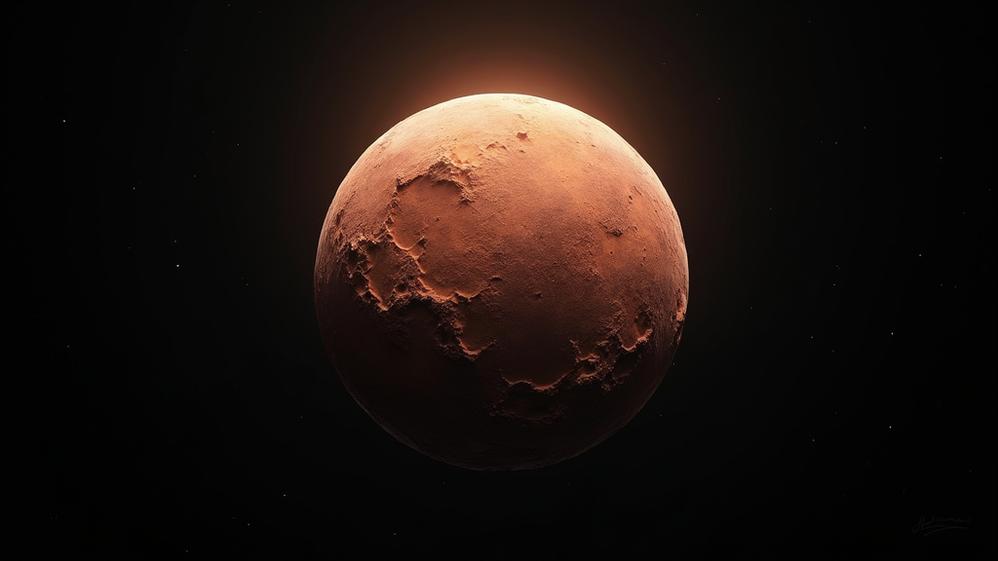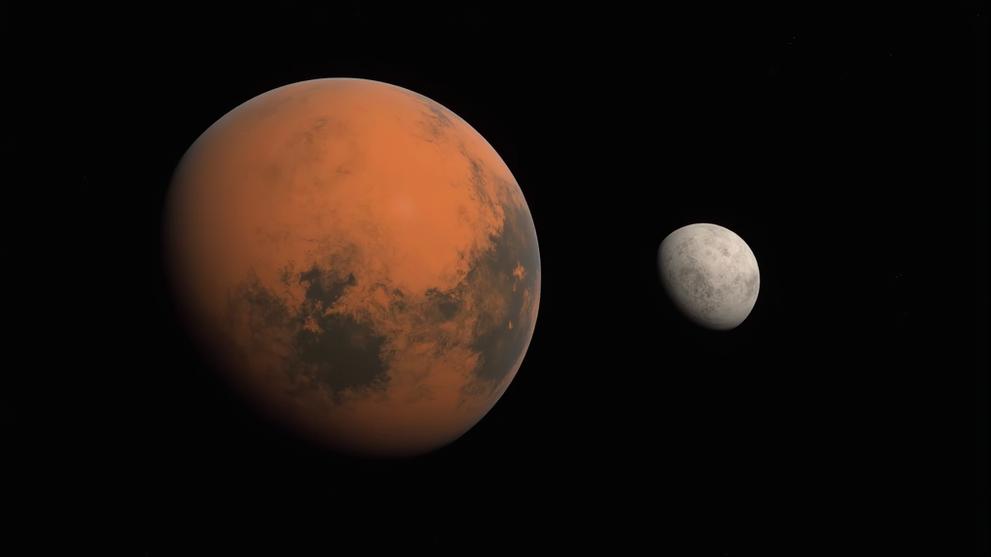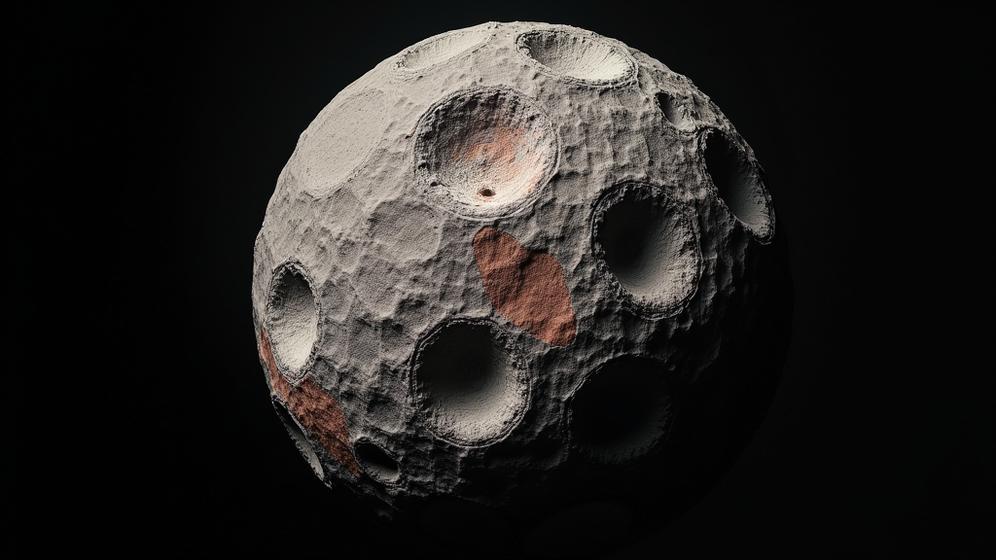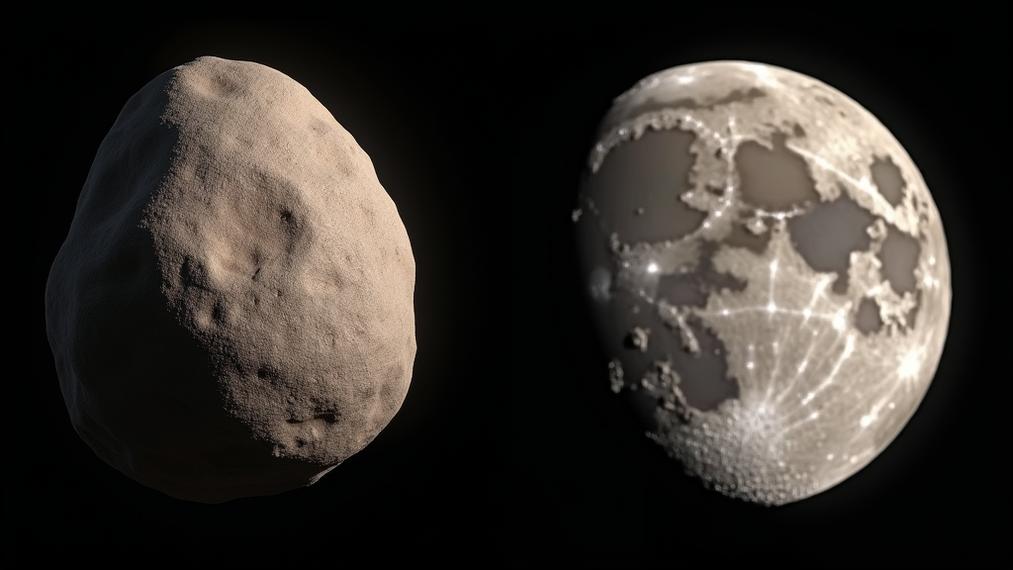Phobos: Distance, Differences, Facts, Size, Surface
Phobos is one of Mars’ two natural satellites, discovered by American astronomer Asaph Hall in 1877. The moon measures approximately 22 kilometers in diameter and is believed to be a captured asteroid composed of carbonaceous chondrite material. Phobos orbits Mars at a distance of 6,000 kilometers above the planet’s surface, closer than any other moon to its parent planet in our solar system. The moon completes one orbit around Mars every 7 hours and 39 minutes, causing tidal interactions that slowly spiral it inward towards the Red Planet.
Phobos differs significantly from Earth’s Moon in size, composition, and orbital characteristics. Earth’s Moon is 100 times larger than Phobos, measuring 2,159 miles in diameter compared to Phobos’ 14 miles. The Moon exerts 1/6th of Earth’s gravity, while Phobos exerts only 1/1000th. Phobos orbits much closer to Mars at 3,700 miles, whereas the Moon orbits Earth at 239,000 miles. The Moon rises in the east, while Phobos rises in the west when viewed from Mars’ surface.
Phobos boasts several intriguing features and facts. The moon’s surface is heavily cratered and marked with distinctive grooves and streaks. Stickney Crater, measuring about 9 kilometers in diameter, dominates Phobos’ landscape as its largest feature. Phobos orbits Mars faster than the planet rotates, completing three orbits per Martian day. Scientists predict Phobos will eventually crash into Mars or form a ring system in about 50 million years.
Phobos has an irregular, potato-like shape measuring 27 km x 22 km x 18 km. The moon’s surface area covers 1,548 square kilometers, with a volume of 5,800 cubic kilometers. Phobos’ size is comparable to Manhattan, making it a significant object for study due to its proximity to Mars.
What is Phobos moon?
Phobos is one of the two natural satellites of Mars, discovered by American astronomer Asaph Hall in 1877. Phobos measures approximately 22 kilometers (14 miles) in diameter, making it larger than its companion moon Deimos. Scientists believe Phobos to be a captured asteroid, composed of carbonaceous chondrite material similar to some asteroids. Phobos orbits Mars at a distance of 6,000 kilometers (3,730 miles) above the planet’s surface, closer than any other moon to its parent planet in our solar system. Phobos completes one orbit around Mars every 7 hours and 39 minutes, causing tidal interactions that slowly spiral it inward towards the Red Planet.
Phobos moons likely originated from the asteroid belt. Mars’ gravity captured Phobos, an asteroid formed elsewhere in the solar system. Phobos has a composition primarily of rock and ice. Phobos crashing or breaking apart will occur when Mars’ gravitational forces exceed the moon’s self-gravity.
How far is Phobos from mars?
Phobos orbits Mars at an average distance of 6,000 kilometers (3,730 miles) from the planet’s center. Phobos is approximately 3,730 miles above the Martian surface. Mars’ moon completes an orbit every 7 hours and 39 minutes. Phobos orbits closer to Mars than Deimos, which orbits at 20,000 kilometers.

What does Phobos look like from mars?
Phobos appears as a large, irregularly shaped object in the Martian sky. Phobos measures 22 kilometers in diameter. Phobos shines 2.5 times brighter than Deimos when viewed from Mars’ surface. Full Phobos appears one-third the size of a full Moon. Phobos looks like a small, scarred object with numerous craters and grooves. Stickney crater dominates Phobos’ surface, measuring about 9 kilometers in diameter. Phobos has a low albedo, reflecting only 6% of sunlight. The moon appears dark in the Martian sky despite its significance as a celestial object.

Is Phobos going to crash into mars?
Phobos will crash into Mars within 50 million years. Scientists predict the collision based on Phobos’ decaying orbit. Phobos loses 1.8 meters of altitude yearly. Phobos orbits Mars at 6,000 kilometers distance, spiraling inward due to tidal interactions. The impact would occur at 2 kilometers per second.
Phobos gets closer to Mars by 1.8 centimeters per year. Scientists estimate Phobos will collide with Mars in 30-50 million years. Phobos is moving towards Mars at 2.14 kilometers per second relative to the planet’s surface. Phobos orbits Mars at such a low altitude that the planet’s gravity will eventually overcome Phobos’s structural integrity.
Phobos going to crash into Mars will create a massive impact. The collision will form a crater hundreds of kilometers wide and eject debris into space. Phobos is expected to disintegrate upon impact due to its 22-kilometer diameter and 2.1 kilometers per second velocity relative to Mars.

What are the differences between Phobos and the Moon?
Earth’s Moon measures 2,159 miles in diameter, 100 times larger than Phobos at 14 miles. Moon exerts 1/6th Earth’s gravity, Phobos only 1/1000th. Moon orbits 239,000 miles from Earth, Phobos 3,700 miles from Mars. Moon formed from collision debris, Phobos likely a captured asteroid. Moon rises in east, Phobos in west.
Orbital characteristics of Phobos and Earth’s Moon vary greatly. Phobos orbits Mars at a distance of only 3,700 miles (6,000 km) from the surface, whereas Earth’s Moon orbits at 239,000 miles (384,400 km) from Earth. Phobos rises in the west and sets in the east when viewed from Mars, unlike Earth’s Moon which moves east to west across Earth’s sky. Phobos completes one orbit around Mars in 7 hours and 39 minutes, while Earth’s Moon takes approximately 27.3 days to orbit Earth.
Origin and appearance distinguish Phobos from Earth’s Moon. Scientists believe Phobos to be a captured asteroid, unlike Earth’s Moon which formed differently. Phobos is heavily cratered and consists primarily of carbonaceous chondrite material. Phobos has a mass of approximately 1.08 x 10^16 kilograms and a surface gravity about 1/1000th of Earth’s gravity.

What are fun facts about Phobos moon?
The fun facts about Phobos moon are listed below.
- Phobos orbits Mars three times per Martian day, making it the closest known moon to its planet.
- The moon circles just 3,700 miles (6,000 km) above Mars’ surface.
- Phobos was named after the Greek god of fear, reflecting its mysterious nature.
- The moon’s surface is heavily cratered and marked with distinctive grooves and streaks.
- Stickney Crater, measuring about 9 km (5.6 mi) in diameter, dominates Phobos’ landscape as its largest feature.
- Phobos has an irregularly shaped form with a mean radius of 11 km (7 mi).
- The moon is slowly spiraling inward towards Mars and will eventually collide with the planet in about 50 million years.
- Asaph Hall discovered Phobos in 1877, along with Mars’ other moon, Deimos.
- Observers on Mars would witness an unusual sight: Phobos appears to rise in the west and set in the east, moving opposite to other celestial bodies.
- Phobos is seven times more massive than its sibling moon Deimos, adding to its significance in the Martian system.
How big is Phobos moon?
Phobos measures 27 km x 22 km x 18 km. Mars’ larger moon has an irregular, potato-like shape. Phobos’ diameter spans approximately 22 km or 14 miles across. Surface area covers 1,548 km². Volume reaches 5,800 km³. Size compares to Manhattan. Proximity to Mars at 6,000 km average distance makes Phobos significant for study.
What is the surface of Phobos like?
Phobos’ surface features numerous craters, including Stickney crater with a 9 km diameter. Long, linear grooves cover the surface, likely formed by tidal interactions with Mars. A thick regolith layer covers these grooves. The surface has a smooth, pitted texture due to low gravity allowing debris to stick. NASA’s Mars Global Surveyor found evidence of water ice.
Phobos’ surface is coated in a dusty powder reaching 1-2 meters thick in certain regions. The crater-scarred terrain contains few distinguishing features due to constant resurfacing from impacts. Solar wind affects the surface dust, causing it to become electrically charged and potentially levitate. Phobos undergoes phases as it orbits Mars at a close distance of 6,000 kilometers, appearing to change shape when viewed from the planet’s surface.
NASA’s Mars Reconnaissance Orbiter and the European Space Agency’s Mars Express mission have extensively studied Phobos’ surface composition and geology. Scientists have conducted numerous studies on Phobos’ orbital dynamics and surface characteristics, contributing to a growing body of research on this Martian moon.
What is the mass of Phobos moon?
Phobos moon has a mass of 1.060×10^16 kg. Mass is approximately 1.08 x 10^16 kg. Phobos is the larger moon of Mars. Mass is significantly smaller than Earth’s Moon. Mass is comparable to other small moons in the solar system. Mass is larger than Deimos’ mass of 4.8×10^15 kg.
What is Phobos moon gravity?
Phobos has extremely low gravity of 0.0006 m/s², about 1/16,000th of Earth’s. Phobos’ gravity equals 0.0006 g. A 68 kg person on Earth weighs 41 grams on Phobos. Escape velocity is only 11 m/s. Phobos’ weak gravitational pull makes stable orbits difficult. Phobos’ rotation is tidally locked to Mars.
How high can you jump on Phobos moon?
Phobos enables humans to jump approximately 57 metres high due to its extremely low gravity. Jumping on Phobos resembles trampoline-like movement. Humans achieve about 20 times their Earth jump height. Scientists base calculations on Phobos’ surface gravity of 0.0057 m/s². NASA’s Planetary Fact Sheet provides data for these calculations.
What is the temperature of Phobos moon?
Phobos experiences extreme temperature fluctuations. Daytime highs reach 25°C (77°F). Nighttime lows plummet to -125°C (-193°F). Average temperatures range from -4°C to 1°C (25°F to 34°F). Fine dust on Phobos’ surface causes rapid heat loss. Lack of atmosphere contributes to these temperature swings. Mars Express orbiter and Phobos 2 spacecraft measured temperatures using infrared radiometry.
Fine dust covers Phobos’ surface, unable to retain heat effectively. Mars Reconnaissance Orbiter and Mars Express have extensively studied Phobos, capturing images and temperature measurements. Phobos orbits close to Mars, within 3,700 miles of the planet’s surface. Scientists hypothesize that Phobos was captured by Mars’ gravity 2.7 billion years ago. Phobos has maintained a stable orbit around Mars since its capture.
What is Phobos moon diameter?
Phobos has an average diameter of 22.2 km. The moon’s dimensions vary due to its irregular shape, with a mean diameter of 22 km. Phobos measures 27 km along its longest axis, representing its maximum length. The widest point of Phobos spans 26.6 km or 14 miles across. Phobos’ shortest axis extends approximately 17 km or 10 miles. The minimum diameter of Phobos is around 19 km. Phobos appears to have a diameter of 21 km when viewed from certain vantage points on Mars. Phobos orbits Mars at a distance of 6,000 km, closer than any other moon to its planet.

